The Health Education Assets Library (HEAL) is a collection of over 22,000 freely available digital materials for health sciences education. The collection is now housed at the University of Utah J. Willard Marriott Digital Library.
TO
Filters: Collection: "ehsl_heal"
| Title | Description | Subject | Collection | ||
|---|---|---|---|---|---|
| 26 |
 |
Basal cell carcinoma: excision removal | This person had a basal cell carcinoma, and the epidermis and dermis were excised. The danger area where the temporal branch of the facial nerve may lie and be quite close to the undersurface of the skin is shown by the straight lines drawn from ear to forehead. The surgeon should be careful to unde... | Surgical Methods | Knowledge Weavers Dermatology |
| 27 |
 |
Goodman | This is a picture of Dr. Goodman (of Goodman & Gillman fame). I once asked him how much you should know about a medication before using it, and he said,A lot! And you can quote me on that! | Knowledge Weavers Dermatology | |
| 28 |
 |
Midbrain | Midbrain. Superior colliculus, red nucleus, III nucleus. Transverse plane. Photograph. Multimedia. | Mesencephalon; Superior colliculus; Red nucleu; Cranial nerves; Oculomotor nerve; Central nervous system; Anatomy | Slice of Life |
| 29 |
 |
Punch biopsy | Punch biopsy is excellent for sampling a skin disease that has multiple essentially identical lesions, or sampling a lesion within the skin. It is designed for full thickness skin biopsy, and is not an effective tool for biopsying the fat. When using it, it should be held as shown, should be spun ve... | Knowledge Weavers Dermatology | |
| 30 |
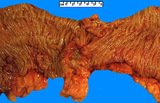 |
Carcinoma, colon | Carcinoma, colon | Knowledge Weavers Pathology | |
| 31 |
 |
Keloid | Before injecting the keloid with the corticosteroid, I recommend injecting local anesthetic into the underlying fat, and waiting about five minutes for the anesthetic to take effect. The anesthetic should not be injected into the keloid as this reduces the amount of space into which one can inject t... | Knowledge Weavers Dermatology | |
| 32 |
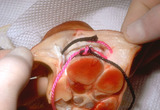 |
Suturing | This demonstrates the deep dermal suture properly placed with the loop, which will be just on the under-surface of the dermis, and the knot will be buried well within the fat. This will prevent the knot from extruding through the dermis and out through the wound. | Knowledge Weavers Dermatology | |
| 33 |
 |
Suturing | The loop is then tightened with the hands in their natural position. This is done four times and then the suture is cut leaving suture ends at .5 cm long. | Knowledge Weavers Dermatology | |
| 34 |
 |
Tearing action | They are then opened which creates a tearing action. | Knowledge Weavers Dermatology | |
| 35 |
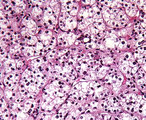 |
Adrenal cortical adenoma | Adrenal cortical adenoma | Andenoma, Adrenal Cortical | Knowledge Weavers Pathology |
| 36 |
 |
Hyaline arteriolosclerosis | Hyaline arteriolosclerosis | Knowledge Weavers Pathology | |
| 37 |
 |
Aphthous stomatitis | Aphthous stomatitis (cankers) involving the tongue. Aphthous stomatitis ulcers are painful, and major aphthous stomatitis induces ulcers that last for many weeks, and sometimes induce scarring. | Canker Sore | Knowledge Weavers Dermatology |
| 38 |
 |
Idiopathic pulomonary fibrosis | Idiopathic pulmonary fibrosis | Pulmonary Fibrosis | Knowledge Weavers Pathology |
| 39 |
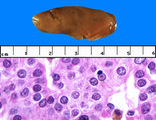 |
Parathyroid, adenoma | Parathyroid, adenoma | Knowledge Weavers Pathology | |
| 40 |
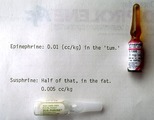 |
Epinephrine | Standard epinephrine (1:1,000) is shown at the top, and the crystalline form (Sus-Phrine) is a concentration of 1:200. Both are administered into the subcutaneous fat, and a dose of epinephrine 1:1,000 is 0.01 cc's per kg, and the dose of Sus-Phrine is half of that (0.005 cc's per kg), and the Sus-P... | Knowledge Weavers Dermatology | |
| 41 |
 |
Excision: suturing | AVis formed as the deep dermal suture exits from the wound, and the suture is pulled so that the short (non-needle bearing end) is about 2 cm long. Both strands of suture should come out on the same side of the loop, and the order must be: loop, short end (non-needle bearing), long end (needle bea... | Knowledge Weavers Dermatology | |
| 42 |
 |
Miliaria | Occlusion of the eccrine sweat glands produces a condition called miliaria; this appears as small red papules and/or vesicles, and associated inflammation. | Knowledge Weavers Dermatology | |
| 43 |
 |
Flea bites | Presumed flea bites. | Knowledge Weavers Dermatology | |
| 44 |
 |
Endocarditis | Endocarditis | Knowledge Weavers Pathology | |
| 45 |
 |
Excision procedure | The following slides are a brief review of the excision procedure. The scalpel is angled outward away from the wound edge to ensure that the wound edges are beveled at about 45 o. | Surgical Methods | Knowledge Weavers Dermatology |
| 46 |
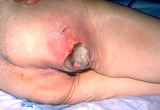 |
Decubitus ulcer | A decubitus ulcer in an older woman in a nursing home. This was induced because the person was lying in one position for too long, and this compromised blood supply to the skin. | Knowledge Weavers Dermatology | |
| 47 |
 |
Forceps | The forceps are held with the non-dominant hand as shown here between the first two or three fingers. | Knowledge Weavers Dermatology | |
| 48 |
 |
Urticaria | Urticaria | Knowledge Weavers Dermatology | |
| 49 |
 |
Giant cell carcinoma | Giant cell carcinoma | Knowledge Weavers Pathology | |
| 50 |
 |
Suturing | This demonstrates that a total of four throws should be made when tying the deep dermal suture, and if done properly, square knots are laid down. It is said that square knots provide optimum knot security. | Knowledge Weavers Dermatology |
